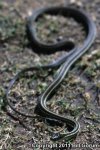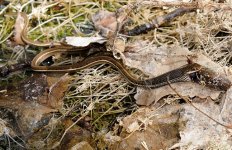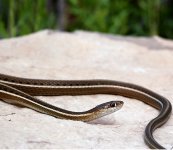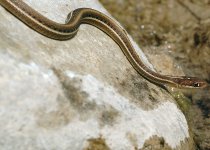| Range: |
 |
| Other Names: |
Garden Snake, Gardener Snake, Grass Snake, Western Ribbon Snake |
| Subspecies: |
Arid Land Ribbon Snake Thamnophis proximus diabolicus |
| Description: |
Adults are 18"-48". A slender snake, Dorsal scales are keeled. Has a
dorsal stripe usually of orange, reddish orange or tan. Lateral
stripe on 3rd or 4th scale rows sometimes bordered by a narrow, dark
stripe. Belly light tan or white and unmarked. |
| Similar Species: |
Ribbons may be confused with other striped species of garters in New Mexico, although it can be separated as follows: Common, Checkered, Blackneck and Terrestrial all have the lateral stripe on scale rows two and three; Mexican and Plains have barred upper labials. The Striped Whipsnake has only 15 scale rows at midbody, the anal plate is divided and the upper stripe in confined to the fourth scale row and the edges of adjacent rows. Patchnoses have a patch-like scale on their nose. |
| Venom: |
Garters were long thought to be nonvenomous, but recent discoveries have revealed that they do in fact produce a mild neurotoxic venom. Garter snakes cannot kill humans with the small amounts of venom they produce, which is comparatively mild, and they also lack an effective means of delivering it. They do have enlarged teeth in the back of their mouth, but their gums are significantly larger. The Duvernoy's gland of garters are posterior (to the rear) of the snake's eyes. The mild venom is spread into wounds through a chewing action. - Wikipedia |
| Habitat: |
Highly adaptable species; temperate woodland, grassland and tropics. Found
along vegetated stream courses. Attracted to permanent water sources such as lakes, ponds, sloughs and marshes. |
| Behavior: |
An alert snake, when frightened often retreats to water. Will emit a foul smelling musk if handled. |
| Hibernation: |
|
| Reproduction: |
Live bearing, has 3-36 young. |
| Diet: |
Feeds on frogs, toads, tadpoles, fish, salamanders, earthworms,
crustaceans and nestlings. Sometimes scavenges. |
Authored by: Garth Teitjen
Sources:



|



















